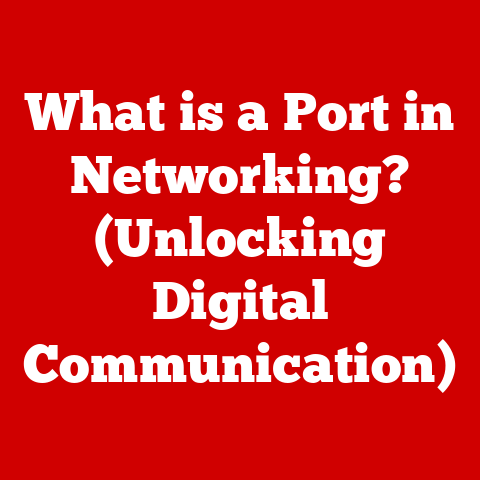What is a C Port? (Unlocking Modern Connectivity)
Imagine this: friends gathered around a table, sharing stories and laughter, their smartphones quietly charging via sleek, identical cables.
A family video chats with loved ones across the country, the connection seamless thanks to the powerful port on their laptop.
Professionals collaborate on a project in real-time, transferring massive files through a single, versatile connection.
These are the moments of connection, convenience, and shared experience that define our modern lives, and at the heart of it all lies a small but mighty technology: the USB-C port.
It’s a symbol of progress, a facilitator of communication, and a testament to the power of technological innovation.
Section 1: Understanding C Ports
A USB-C port, often referred to as a C Port, is a 24-pin USB connector system with a rotationally symmetrical connector.
This means you can plug it in either way up, eliminating the frustration of fumbling with older USB types.
Beyond its convenient design, the USB-C port is designed to transmit data, video, and power, making it a versatile connector for a wide range of devices.
The term “C Port” is essentially a shortened, more colloquial way of referring to the USB-C connector.
“USB” stands for Universal Serial Bus, a standard developed to simplify the connection of peripherals to computers.
The “C” designates the connector’s shape and features, distinguishing it from older USB types like A and B.
The development of USB-C was driven by the need for a more versatile, powerful, and user-friendly connector.
Previous USB standards, while revolutionary in their time, suffered from limitations in data transfer speeds, power delivery, and physical design.
The USB Implementers Forum (USB-IF), a group of companies responsible for developing, maintaining, and promoting USB specifications, introduced USB-C to address these shortcomings.
The first USB-C devices started appearing around 2015, and its adoption has steadily grown since then.
Section 2: The Technical Advantages of C Ports
C Ports offer several key technical advantages over their predecessors:
- Reversible Connector: The symmetrical design eliminates the need to worry about orientation when plugging in a cable.
- High Data Transfer Speeds: USB-C ports can support the latest USB standards, such as USB 3.2 and USB4, enabling data transfer speeds of up to 40 Gbps.
- Power Delivery (USB PD): C Ports can deliver significantly more power than older USB types, allowing them to charge laptops, monitors, and other power-hungry devices.
USB PD can deliver up to 100W (240W with the latest specification), making it possible to fast-charge even larger devices. - Alternate Modes (Alt Modes): USB-C ports can support alternate modes, allowing them to transmit other types of signals, such as DisplayPort for video output or Thunderbolt for high-speed data and video.
In the real world, C Ports are used everywhere.
Smartphones use them for charging and data transfer.
Laptops use them to connect to external displays, docks, and power adapters.
Tablets leverage them for connecting peripherals and charging.
Even external hard drives and SSDs are increasingly adopting USB-C for faster data transfers.
Section 3: C Port in Everyday Life
The impact of C Ports on everyday technology use is undeniable.
No more searching for the “right” way to plug in a cable; the reversible design simplifies the process.
The ability to charge laptops with the same cable used for smartphones reduces clutter and increases convenience.
Connecting an external display to a laptop with a single USB-C cable that also provides power is a game-changer for productivity.
Imagine a student who uses their USB-C laptop to take notes in class, then connects it to a large monitor at home with a single cable for immersive studying.
Or a photographer who quickly transfers high-resolution photos from their camera to their laptop using a USB-C connection.
These are just a few examples of how C Ports streamline our daily routines.
The universal compatibility of C Ports also simplifies the user experience.
No more carrying around multiple chargers for different devices; a single USB-C charger can often handle them all.
This standardization not only reduces clutter but also promotes sustainability by reducing the need for multiple cables and chargers.
Section 4: The Future of C Ports
The future of C Ports is bright, with continued advancements on the horizon.
We can expect to see even faster data transfer speeds, potentially exceeding 40 Gbps with future USB standards.
Power delivery capabilities will likely increase, allowing C Ports to power even more demanding devices.
The adoption of C Ports across industries is expected to continue.
Consumer electronics, automotive, and smart home technology will all benefit from the versatility and power of USB-C.
Electric vehicles, for example, might use USB-C for charging and data transfer between the car and external devices.
Smart home hubs could use USB-C to connect to various sensors and devices.
Standardizing connectors also has a positive environmental impact.
By reducing the need for multiple cables and chargers, we can reduce electronic waste and promote a more sustainable future.
This is especially important as we move towards a more circular economy, where products are designed to be easily disassembled and recycled.
Section 5: C Ports and Connectivity Standards
C Ports are not just a connector; they are a gateway to a broader ecosystem of connectivity standards.
They support technologies like Thunderbolt 3 and 4, DisplayPort, and HDMI through Alternate Modes.
- Thunderbolt: A high-speed data and video interface developed by Intel and Apple.
Thunderbolt 3 and 4 use the USB-C connector and offer speeds of up to 40 Gbps. - DisplayPort: A digital display interface used to connect a video source to a display device.
USB-C ports can support DisplayPort Alternate Mode, allowing them to output video signals to a monitor. - HDMI: Another digital display interface commonly used to connect TVs, monitors, and other devices.
While not as common as DisplayPort over USB-C, HDMI Alternate Mode is also supported by some devices.
The interoperability of C Ports with these technologies is crucial.
It allows users to connect a wide range of devices to their computers and smartphones using a single port.
This cross-compatibility simplifies the user experience and promotes a more seamless ecosystem.
C Ports also play a significant role in the Internet of Things (IoT).
As the number of smart devices continues to grow, the need for standardized connectivity becomes even more important.
USB-C provides a reliable and versatile connection for IoT devices, enabling them to communicate with each other and with the cloud.
Section 6: Overcoming Challenges and Misconceptions
Despite their many advantages, C Ports are not without their challenges and misconceptions.
- Compatibility Issues: Not all USB-C ports are created equal.
Some may only support USB 2.0 speeds, while others may not support Power Delivery or Alternate Modes.
It’s important to check the specifications of a device’s USB-C port before connecting it to other devices. - Performance Limitations: While USB-C can support high data transfer speeds, the actual speed depends on the capabilities of both the port and the connected device.
A USB-C port on an older device may not be able to take full advantage of the latest USB standards.
Transitioning to C Ports from older USB standards can also be challenging.
Users may need to purchase new cables and adapters to connect their older devices to USB-C ports.
Understanding the different types of USB-C cables and their capabilities is also essential.
Manufacturers are addressing these challenges by providing clear specifications for their USB-C ports and by including adapters in the box with their devices.
They are also working to educate consumers about the different types of USB-C cables and their capabilities.
Conclusion: The Impact of C Ports on Modern Connectivity
The USB-C port has revolutionized the way we connect and interact with technology.
Its reversible design, high data transfer speeds, and power delivery capabilities have simplified our lives and enabled new possibilities.
From charging our smartphones to connecting external displays, C Ports have become an essential part of our daily routines.
Remember the opening scene?
The friends sharing stories, the family video chatting, the professionals collaborating – all powered by the seamless connectivity of USB-C.
These connections are more than just technological; they are emotional.
They allow us to stay connected with loved ones, to share experiences, and to build relationships.
As we look to the future, the potential for C Ports to continue shaping the landscape of connectivity is immense.
With ongoing advancements and widespread adoption, USB-C will continue to play a critical role in our increasingly digital lives, keeping us connected and empowered in a world that is constantly evolving.
The USB-C port is not just a connector; it’s a gateway to a more connected, convenient, and sustainable future.






